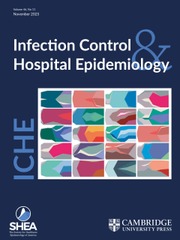No CrossRef data available.
Article contents
Validation of an electronic algorithm to identify appropriate antibiotic use for community-acquired pneumonia in hospitalized children
Published online by Cambridge University Press: 28 October 2025
Abstract
Algorithms using electronic health record data to identify children with community-acquired pneumonia (CAP) and to evaluate the appropriateness of antibiotic use may facilitate antibiotic stewardship efforts, but validated measures of antibiotic choice and duration are unavailable.
We performed a cross-sectional study within a single hospital system, including hospitalized children ages 6 months to 17 years who were admitted between 1/1/2019 and 10/31/2022. CAP was defined electronically as an ICD-10 code for pneumonia, a chest x-ray or chest CT within 48 hours of admission, and at least two days of antibiotics starting within 48 hours of admission. Hospital transfers and those who died within 48 hours or had chronic conditions, intensive care unit stays ≥48 hours, or concurrent infections were excluded. We validated electronic measures of appropriate antibiotic choice and duration using a reference standard of manual chart review. Sensitivity, specificity, positive predictive value (PPV), and negative predictive value (NPV) were calculated for each metric.
The electronic algorithm identified 1058 CAP encounters, and 100 were randomly selected for validation. Inappropriate antibiotic choice and duration occurred in one and 75 encounters of the 100 encounters, respectively, based on manual chart review. The electronic algorithm had a sensitivity of 100%, specificity of 93%, PPV of 14%, and NPV of 100% for inappropriate antibiotic choice and a sensitivity of 97%, specificity of 88%, PPV of 96%, and NPV of 92% for inappropriate antibiotic duration.
Metrics of inappropriate antibiotic choice and duration had acceptable performance characteristics and may facilitate syndrome-based stewardship efforts.
Information
- Type
- Original Article
- Information
- Copyright
- © The Author(s), 2025. Published by Cambridge University Press on behalf of The Society for Healthcare Epidemiology of America


